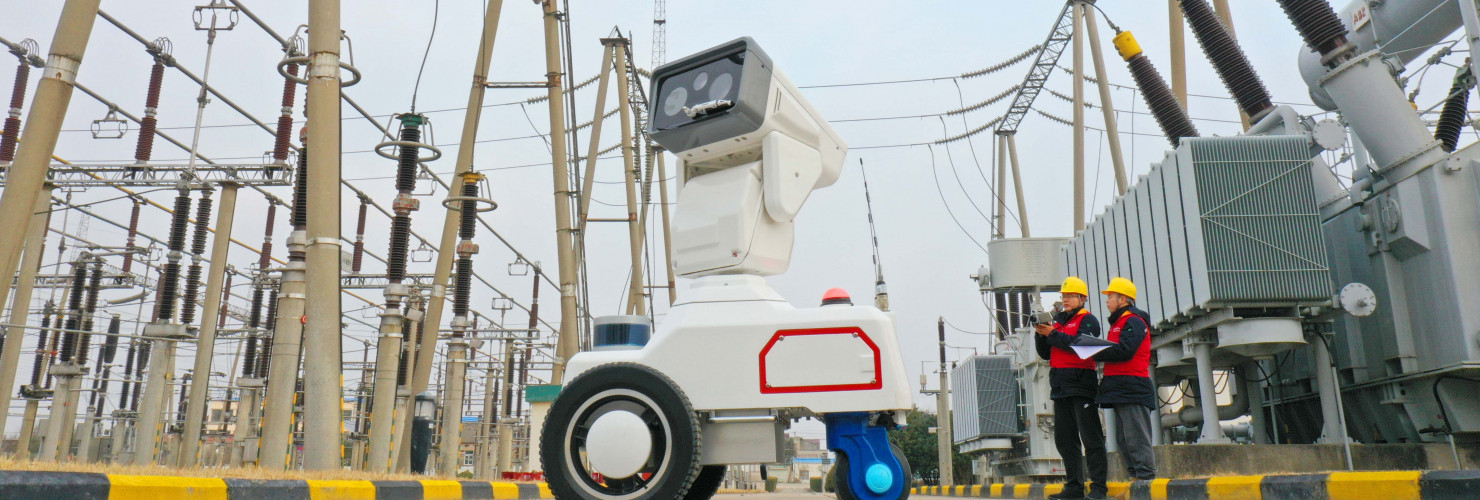

5G applications in the energy sector + Provincial protectionism + Support for high-tech SMEs
MERICS Top 5
1. Beijing promotes 5G applications in the energy sector
At a glance: The National Energy Administration (NEA) and Ministry of Industry and Information Technology (MIIT) issued a report detailing 33 examples of 5G applications within the energy sector. The case studies cover areas such as smart power plants, smart grids, smart coal production and smart manufacturing. They are intended to act as models for other firms, accelerating the adoption of 5G technology and generating greater efficiency and safety.
Each case study details the challenges faced by the company, the 5G solution, the supporting technology as well as the key economic, environmental and social benefits. Examples of 5G applications include:
- Yuanmou Wumao Photovoltaic Power Plant: To identify equipment errors, assess operation efficiency, operate ground and aerial drones to perform maintenance checks, etc.; operations and maintenance efficiency increased by 46.7 percent
- State Grid Zhejiang Electric Power: To develop an energy network integrating the sources, grid, load and storage of power, as well as to monitor the performance of power lines; as much as CNY 1 billion in power grid related investments in Zhejiang potentially saved
MERICS comment: China is leading the rollout of 5G infrastructure – it accounts for 60 percent of the world’s 5G base stations – and policymakers now want industry to take advantage. According to the 14th Five-Year Plan, the government is organizing further pilot demonstrations of 5G application scenarios in areas such as smart transport, smart logistics, smart energy, and smart healthcare.
Beijing is using SOEs, which dominate the energy sector, to spearhead the adoption of 5G applications. SOEs are particularly responsive to government directives and have the necessary size and capital required to make related investments. As of June 2022, 5G-based solutions were applied in more than 200 smart mines, over 1,000 smart factories, over 180 smart grids, and 89 ports.
The government’s continued focus on digitalization and 5G technology could increase the competitiveness of Chinese firms, particularly in third markets. Through marketing the enhanced efficiency and safety of their energy projects, Chinese SOEs may be able to secure more contracts in emerging countries, where concerns about data security are not as high as in advanced economies.
Article: Notice on "A Compilation of Typical Cases of 5G Application in the Energy Field in 2022"(国家能源局综合司 工业和信息化部办公厅 关于印发《2022年度能源领域5G应用典型案例汇编》的通知) (Link)
Issuing bodies: NEA, MIIT
Date: May 5, 2022
2. Market regulator moves to tackle provincial protectionism
At a glance: The State Administration for Market Regulation (SAMR) issued draft revisions to the regulations on reviewing fair competition. The main updates to the competition review system aim to:
- Prevent policymakers from formulating policies that foster anti-competitive practices, such as market access and exit barriers or preventing the free flow of goods and production factors
- Conduct internal reviews of improvements to the existing review mechanisms of fair competition before implementing policies that impact economic activities
- Coordinate oversight at the national and the local level and provide the SAMR with the authority to penalize local government agencies
MERICS comment: The regulation is the latest attempt by the State Council to combat unfair competition and establish a “unified market economy.” Relevant laws were recently amended or are currently being revised. In April 2023, the SAMR announced it is revising 27 different laws and regulations.
The primary legislative intent of the fair competition review regulations is to combat provincial protectionism and to prevent discriminatory incentive structures. Local tax incentives and financial subsidies have been important factors in attracting business investments and establishing manufacturing plants. However, they also weaken fair competition between different localities. As Beijing renews efforts to attract foreign investment, especially for R&D and high-tech manufacturing, these regulations will serve to prevent local authorities from providing excessive support.
If the amendments are approved and thoroughly implemented, they could lead to the withdrawal of some local tax incentives. A more “level playing field” across China’s provinces is likely to have an ambivalent impact on foreign companies. Those who benefit from local support may see some benefits retracted and require them to reassess the type of support they can expect going forward. Yet the same could occur to domestic firms with regional advantages, thus enabling foreign firms to compete on a more even footing. Ultimately, the proof will be in the pudding in terms of how the rules will be applied. Promoting fair competition nationwide is likely to be an uphill battle, as local governments pursue their self-interest in making their regions as attractive as possible.
Article: Announcement on the “Regulations on the Fair Competition Review (Draft for Comment)” (市场监管总局关于《公平竞争审查条例(征求意见稿)》公开征求意见的公告) (Link)
Issuing body: SAMR
Date: May 12, 2023
3. Beijing accelerates support for high-tech SMEs with focus on knowledge exchange and quality improvements
At a glance: Several ministries and government bodies, led by the MIIT, issued two special action plans to promote the high-quality development of small and medium-sized enterprises (SMEs) in manufacturing. The first plan intends to improve SME access to science and technology achievements while the second plan promotes SME quality, branding, and standard-setting capabilities. Key goals for 2025 include:
- Promote collaboration between SMEs and research institutes, universities, and large firms; and pilot cooperation programs between SME clusters and tech transfer institutions
- Carry out at least 30 activities (such as exhibits, roadshows or industry-finance docking events) to disseminate tech developments and foster R&D cooperation
- Support SMEs in traditional industries such as textiles and steel to move to the high value-added activities of their value chains
- Provide SMEs with access to managerial training, testing and inspection equipment (for instance through “testing vouchers”) and quality production training
MERICS comment: Beijing’s SME promotion push continues to gather pace. Having selected 8,947 Little Giants (with plans to have 10,000 by year end) the focus is now increasingly on cultivating and further supporting their development so that they can challenge established foreign suppliers, drive the development of new technologies and gain global market share.
Long-standing policy priorities such as to improve the product and brand quality of Chinese enterprises and rapidly commercializing basic research are now increasingly tailored towards SMEs, especially those that are certified by the government. Indeed, the push to let SMEs benefit from tech transfer and commercialize S&T achievements fits into Beijing’s agenda for universities and research institutes who are strongly encouraged to dedicate research resources towards technological bottleneck and emerging industries.
Foreign firms, especially those supplying high-tech components in areas deemed as strategic by Chinese policymakers, should expect greater competition from China’s SMEs who are showered with subsidies and support measures. However, foreign producers of testing equipment makers and professional quality testing and certifications firms like Germany’s Technical Inspection Associations (TÜVs) could benefit from an uptick in demand for their products and services.
Article: Science And Technology Achievements to Empower Intelligent Small and Medium-Sized Enterprises Special Action Plan (2023-2025) (科技成果赋智中小企业专项行动(2023—2025年)(Link) Quality Standards Brand Empowerment of Small and Medium-Sized Enterprises Special Action Plan (2023-2025)质量标准品牌赋值中小企业专项行动(2023-2025年)(Link)
Issuing bodies: MIIT et. al.
Date: May 22, 2023
4. Basic research funder steps up efforts to stamp out corruption
At a glance: The National Natural Science Foundation of China (NSFC) banned 22 practices, addressing different participants in research funding allocation:
- Researchers cannot collect information on the selection committee, its members and meetings, canvas selection committee members, or ask intermediaries to exert influence
- Selection committee members cannot accept bribes, let personal ties affect their decisions or share information that is not public
- Similar prohibitions address those who organize the selection process and NSFC employees.
The document does not specify punishments.
MERICS comment: With a CNY 34 billion budget for 2023, the NSFC is a major pillar of China’s public research funding. Allocating this funding is prone to corruption. Between 2018 and 2021, over 70 percent of selection committee members were approached by applicants, the NSFC found. In 2018, 19 percent of survey respondents witnessed gifts and dinner invitations. Last year, a professor lobbied in a large WeChat group with academics for his daughter’s post-doc application.
Although ethics regulations outlaw these practices since 2020 (upheld in 2022 regulations), the NSFC is aiming for a gradual cultural change rather than a radical break. Out of the 20,000 projects approved in 2022 only two were found to have interfered in selection procedures, leading to 3 to 5-year bans from NSFC funding for the three researchers involved.
This soft approach aligns with the political atmosphere, which has less tolerance for corruption, but an even stronger need for entrepreneurial scientists, as well as less trust in globally accepted solutions, such as citation scores, transparency and public scrutiny. For instance, the NSFC and its supervising agency, the Ministry of Science and Technology, do not have a proper system for whistleblowers.
As a result, the NSFC and other Chinese research funders will repeatedly appeal to the ethical conscious of Chinese researchers and administrators. The continuity of old boys networks will harm the effectiveness of China’s research funding and innovative capacity, although Beijing believes its approach can overcome this. This tension should also alert European innovators that they remain disadvantaged in China by a lack of personal connections.
Article: Notice on the List of Prohibited Behaviors of the National Natural Science Foundation of China (Draft for Comment) (国家自然科学基金委员会关于征求《国家自然科学基金项目评审请托行为禁止清单(征求意见稿)》公众意见的公告) (link)
Issuing body: NSFC
Date: May 16, 2023
5. Xi emphasizes real economy in top-level meeting
At a glance: On May 5, Chinese President Xi Jinping chaired a meeting of the Central Financial and Economic Affairs Commission (CFEAC). The CFEAC is the CCP’s highest and most important body for coordinating economic policy. During the meeting, President Xi identified, among other goals, the commission’s primary objective: to hasten the construction of a modern industrial system. To achieve that, Xi prioritized the following:
- Focus on the real economy as the driver of development
- Advance primary, secondary, and tertiary sectors simultaneously
- Continue to uphold China’s strength in traditional manufacturing, even in low value-added segments
- Foster and apply innovation and its results, such as artificial intelligence
MERICS comment: The drive towards technological self-reliance motivates Xi’s reference to focusing on the “real economy”. Importantly, in CCP party-speak, this refers to measures meant to steer some of China’s most innovative companies away from areas like consumer internet applications and towards the “real” hardware and software that China needs to build a geopolitically-resilient economy. Effectively, Beijing wants firms like Alibaba and Tencent to focus more on the tech that the country needs for national and economic security.
In contrast to other advanced manufacturing players that have focused on high value-added sectors and outsourced many parts of low value-added industry segments, China is keen to hold onto traditional industries and transform them using new technologies such as AI. That thinking indicates that Beijing feels production outside its own borders is inherently unsafe, even in traditional low value-added industries. To prevent manufacturing moving to lower cost countries, China needs to invest even more in automation and incentivize producers to keep a sizeable share of production local. China’s massive market will surely help to realize these plans.
Article: Xi Jinping Presides over the First Meeting of the Central Financial and Economic Commission (习近平主持召开二十届中央财经委员会第一次会议) (Link)
Issuing body: State Council
Date: May 5, 2023
Noteworthy
Noteworthy
Policy news
May 5: The executive meeting of the State Council approved measures to accelerate the development of advanced manufacturing clusters; the meeting highlighted their importance in moving up the value chain and strengthening the resilience and security of the supply chain (State Council notice)
May 5: MIIT issued drafts of four national automobile standards including on technical requirements for vehicle information security and autonomous driving data recording systems for intelligent connected vehicles (MIIT notice, Yicai article)
May 10: Following approval by the Ministry of Science and Technology, China’s National Blockchain Technology Innovation Center opened in Beijing; the research center will help China reach its goal to train 500,000 blockchain professionals (Xinhua article, South China Morning Post article)
May 22: MIIT released guidelines for the development of industrial data security standards; the policy aims to develop more than 30 national, industry or group standards related to industrial data security by 2024 (MIIT notice)
May 22: MIIT published a list of Little Giant firms selected for additional financial support, based on their performance evaluation, as well as a list of public service platforms to be supported (MIIT notice)
May 23: The Cyberspace Administration of China released the Digital China Development Report (2022); key goals for 2023 include building a secure digital technology innovation system and enhance digital security overall (CAC notice)
May 24: The State Council issued revised regulations on commercial encryption due to come into force on July 1, 2023 (State Council notice, Data Guidance article)
Corporate news
May 9: Microsoft-subsidiary LinkedIn announced that it is closing down the Chinese version of its social networking services, InCareer, due to China’s challenging operating environment and fierce competition (Financial Times article)
May 16: American carmaker Ford said that it will scale back future China investments amid dipping sales, geopolitical tensions and strong local competition (Financial Times article)
May 21: After a security probe Beijing has told Chinese firms dealing with critical information to halt purchases of Micron Technology memory chips (CAC notice)
May 23: German medtech company Siemens Healthineers has announced plans to invest USD 142 million to construct a second research and production base in Shenzhen (Yicai article)
May 28: COMAC’s C919 passenger jet has completed its first commercial flight from Shanghai to Beijing (South China Morning Post article)


